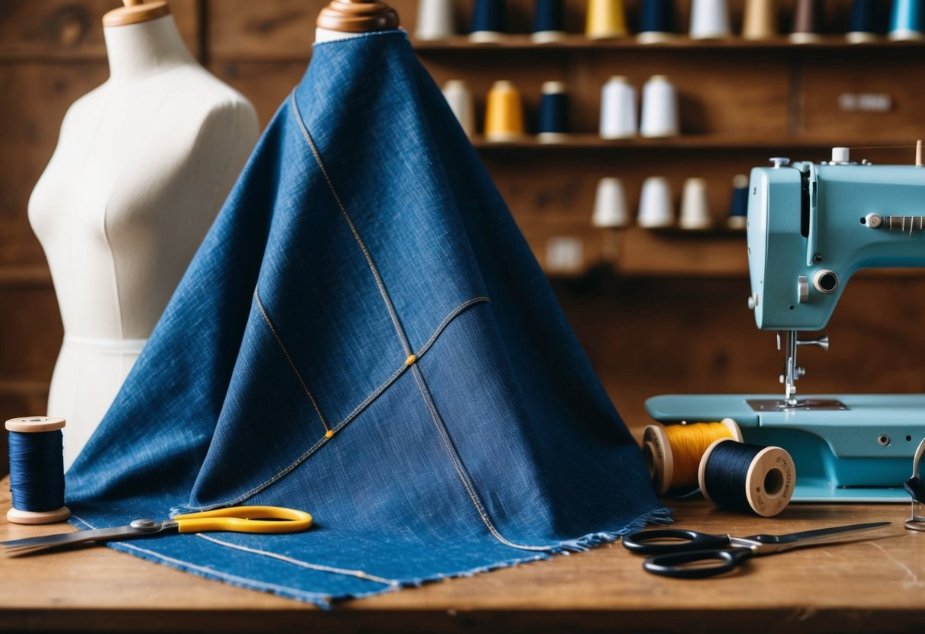From raw selvedge to stretch: Navigate the world of jeans with expert insights on choosing, wearing, and maintaining your perfect pair
Denim is more than just a fabric – it’s a cultural icon that has shaped fashion for over 150 years. Raw denim starts as a dark blue material that develops unique wear patterns over time, creating personalised character in each garment. Made from 100% cotton in a distinctive twill weave, denim is one of the most durable and versatile fabrics available, which explains its enduring popularity in clothing.
The blue colour comes from indigo dye, traditionally extracted from plants but now produced synthetically. This dyeing process requires multiple dips to achieve the deep blue shade that denim is famous for. Unwashed denim is also a more sustainable choice, using less water than pre-washed varieties.
On This Page
Key Takeaways
- Denim’s durability and versatility make it an essential fabric for everyday wear
- The distinctive indigo dyeing process creates unique wear patterns specific to each garment
- Raw denim offers both personalised character and environmental benefits
History and Evolution of Denim
Denim’s journey from a humble European textile to a global fashion phenomenon spans over 400 years. The fabric has shaped both workwear and popular culture through innovative dyeing techniques, entrepreneurial vision, and widespread cultural adoption.
Indigo and the Rise of Blue Jeans
Denim originated in 16th-century Europe, specifically in the French city of Nîmes. The name ‘denim‘ comes from ‘serge de Nîmes’, the sturdy cotton twill fabric that local weavers produced.
The distinctive blue colour came from indigo dye, which created a uniquely fade-resistant and durable material. Workers prized this hardy cloth for its strength and ability to show wear patterns that told the story of their labour.
Indigo-dyed denim proved particularly useful for manual labour due to its ability to hide dirt and stains. The deep blue shade became synonymous with working-class durability.
Levi Strauss and the Iconic 501s
In 1873, Levi Strauss revolutionised workwear by adding metal rivets to strengthen the weak points of denim trousers. This innovation created the first pair of blue jeans.
The original Levi’s 501 design featured:
- Copper rivets at stress points
- Button fly closure
- Two back pockets
- Sturdy straight-leg cut
These jeans quickly became essential gear for miners and labourers during the American Gold Rush. Their practicality and durability made them indispensable workwear.
Popularity of Jeans Worldwide
By the 1950s, jeans transformed from workwear into a symbol of youth rebellion. Film stars like James Dean popularised denim as casual wear, shifting its image from pure utility to fashion statement.
The 1960s and 1970s saw jeans become a universal garment. People of all social classes embraced denim, leading to new styles and washes. Designer brands began creating premium jeans, elevating the fabric’s status.
Today, the average person owns multiple pairs of jeans. The global denim market continues to grow with new sustainable production methods and innovative designs meeting modern consumer demands.
Understanding Denim Fabric
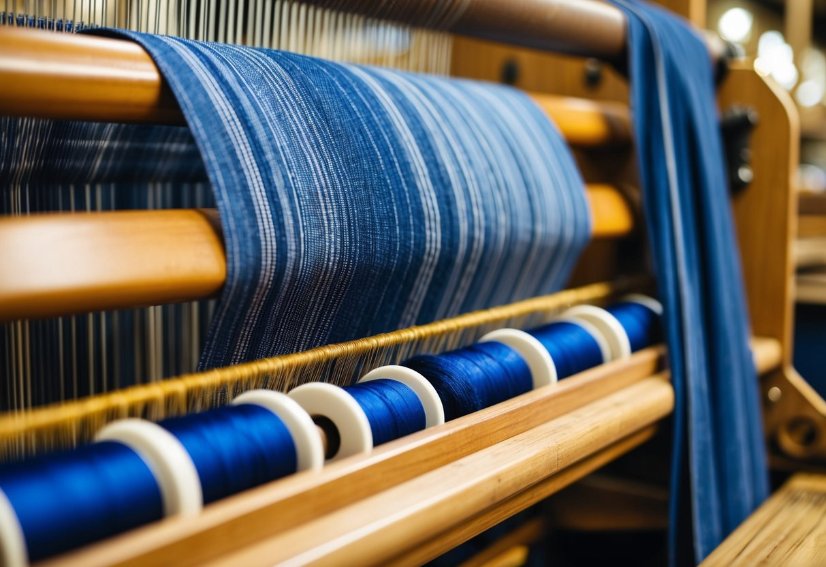
Denim is a sturdy cotton twill textile where the warp thread is dyed blue whilst the weft remains white. The unique weaving pattern creates the distinctive diagonal ribbing that sets denim apart from other fabrics.
Cotton and Textile Production
The journey of denim begins with cotton cultivation. Mills spin cotton fibres into yarns, which they then dye using indigo. Traditional indigo dyeing creates the signature blue colour that fades naturally over time.
The weaving process uses a twill construction, where the warp threads pass over one or more weft threads before going under two or more weft threads. This creates the characteristic diagonal pattern.
Modern denim production often incorporates elastane or polyester with cotton to create stretch denim for improved comfort.
Raw Denim vs Sanforized Denim
Raw denim, also called dry denim, comes straight from the loom without any pre-washing or treatment. It feels stiff at first but develops unique fade patterns based on the wearer’s movements and lifestyle.
Sanforized denim undergoes a pre-shrinking process to prevent significant size changes after washing. This treatment makes the fabric more stable and consumer-friendly.
Most modern denim is sanforized, with only about 1% shrinkage after washing. Unsanforized denim can shrink up to 10% when first washed.
Selvedge Denim and Its Significance
Selvedge denim comes from traditional shuttle looms that create a self-finished edge. These narrow shuttle looms produce a tighter weave and typically create higher quality fabric.
The selvedge edge appears as a clean, finished band when the jeans are cuffed. Manufacturers often use different coloured threads in the selvedge line to identify their specific mill.
Traditional selvedge denim production is slower and more costly, but many enthusiasts prize it for its authenticity and superior construction.
Manufacturing and Craftsmanship
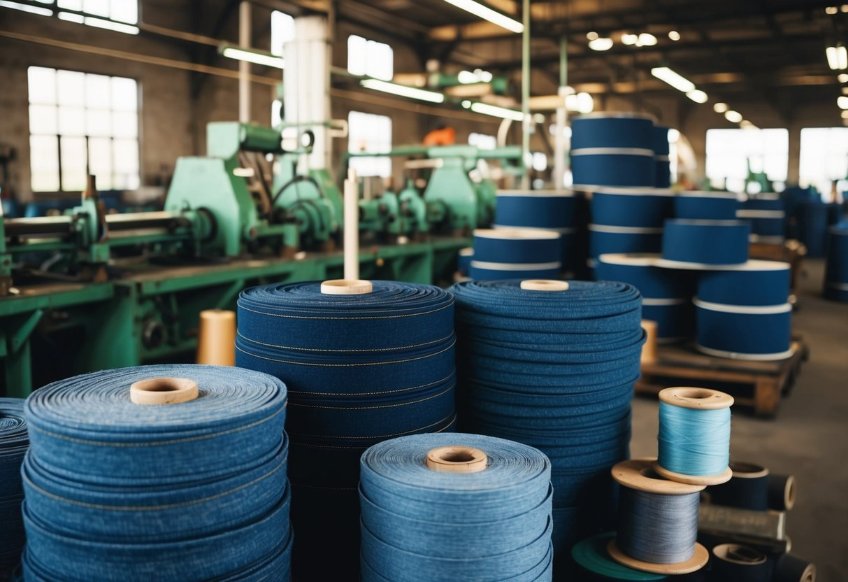
The creation of denim requires precise techniques, skilled artisans, and specialised equipment to produce fabric that meets strict quality standards. Each step adds unique character whilst maintaining durability.
Denim Weaving Techniques
Denim weaving involves specialised looms that create the distinctive diagonal pattern known as twill. The warp yarns run lengthwise, whilst the weft yarns cross horizontally.
Traditional shuttle looms produce a tighter, denser weave with a self-edge that prevents fraying. Modern projectile looms work faster but create an open-end weave.
The tension must be carefully controlled during weaving to ensure uniform fabric density. Quality control teams check for defects like slubs or broken yarns.
Dyeing and Treatment Processes
The dyeing process gives denim its iconic blue colour. Indigo dye penetrates only the surface of the yarn, creating the characteristic fade pattern over time.
Most manufacturers use a rope dyeing method where yarns are twisted into rope-like strands and dipped repeatedly in indigo baths. Each dip intensifies the colour saturation.
Pre-treatment processes include:
- Singeing to remove loose fibres
- Mercerising to increase dye absorption
- Sizing to strengthen warp yarns
The Art of Denim Stitching
Premium denim requires precise stitching techniques to ensure longevity. Chain stitching creates strong, flexible seams that can withstand daily wear.
Authentic selvage denim features distinctive red-lined edges that showcase traditional craftsmanship. These edges prevent fraying and add structural integrity.
Key stitching elements include:
- Reinforced pockets: Double or triple-stitched for durability
- Bar tacks: Strengthens stress points
- Rivets: Placed at pocket corners to prevent tearing
Denim Care and Maintenance

Proper denim care extends the life of jeans and maintains their shape, colour, and fit. The right washing methods, repair techniques, and eco-friendly practices keep denim looking fresh for years.
Washing and Drying Tips
Washing denim requires special attention to preserve its quality. Turn jeans inside out before washing to protect the outer surface and reduce fading.
Use cold water and mild detergent specifically made for dark clothes. Skip the dryer when possible – air drying helps maintain the fabric’s strength and prevents shrinkage.
Wash jeans only when necessary – every 5-10 wears unless visibly dirty. Too frequent washing breaks down the fibres and fades the colour faster.
Repair and Longevity Strategies
Small repairs can significantly extend jean lifespan. Fix loose buttons and small tears promptly before they become larger problems.
Common repair needs:
- Patch holes in high-stress areas
- Reinforce worn seams
- Replace broken zips
- Fix loose rivets
Avoid wearing extremely tight jeans that strain the fabric. Store denim flat or hung properly to prevent creasing and misshaping.
Sustainable Care Practices
Water conservation in denim care makes a significant environmental impact. Spot clean stains instead of washing entire garments.
Use eco-friendly detergents free from harsh chemicals. Consider collecting multiple pairs for washing together to save water and energy.
Sustainable care tips:
- Air dry to reduce energy use
- Choose non-toxic cleaning products
- Repair rather than replace
- Donate unwanted jeans
Styles and Fittings
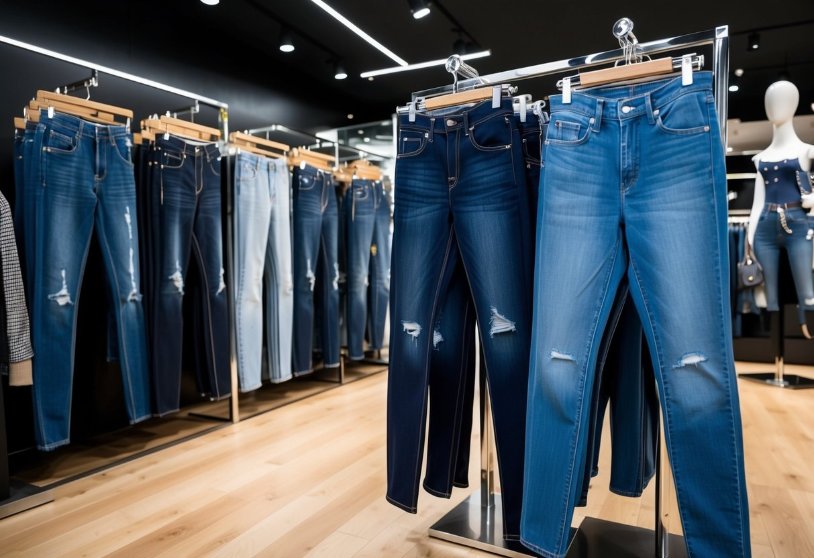
The perfect pair of jeans combines the right weight of denim, an ideal fit for your body type, and personal touches that make them uniquely yours. Smart-casual dress codes now welcome denim as a wardrobe essential.
Understanding Denim Weights
Denim weight measures the fabric’s thickness in ounces per square yard. Light denim weighs 8-12 oz and works well for summer wear. Mid-weight denim ranges from 12-16 oz, making it ideal for everyday use.
Heavy denim starts at 16 oz and can reach up to 32 oz. These jeans offer maximum durability and develop unique wear patterns over time.
Raw denim comes unwashed and untreated, allowing for natural fading and personalised wear patterns. Pre-washed denim provides immediate comfort but may show less distinctive ageing.
Identifying Fits: Skinny to Relaxed
Tapered jeans offer room in the thigh while narrowing towards the ankle, suiting athletic builds perfectly. Straight-leg styles maintain the same width throughout the leg.
Loose-fitting denim has gained popularity in recent trends, replacing the ultra-skinny styles of previous years.
Classic five-pocket designs include two front pockets, two back pockets, and a small watch pocket. Most styles feature belt loops and a zip or button fly.
Customisations and Personalisation
Distressing adds character through strategic wear patterns, tears, or fading. Natural distressing develops through regular wear, while manufactured distressing offers immediate lived-in appeal.
Stretch content ranges from 1% to 4%, improving comfort and movement. Pure cotton denim offers traditional appeal but requires more breaking in.
Popular modifications include:
- Custom hemming for perfect length
- Adding patches or repairs
- DIY distressing
- Chain-stitched personalisation
Signature Features of Jeans
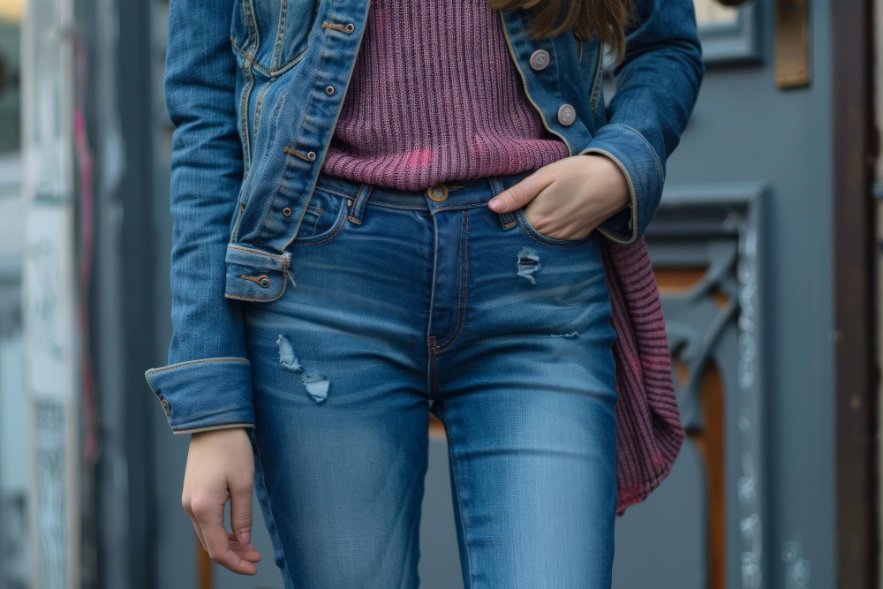
Blue jeans combine sturdy metal hardware with distinct fabric patterns to create their iconic appearance and legendary durability.
Recognising Denim Patterns
Distinct wear patterns emerge on denim through regular use. These marks give each pair their unique character.
Whiskers form horizontal fades across the hip and thigh area. These lines develop naturally from sitting and movement.
Honeycombs appear behind the knees as distinctive diamond-shaped creases. They form from the repeated bending motion of walking.
These patterns vary based on the wearer’s habits and movement. Raw denim shows these patterns most clearly after several months of wear.
The Function of Rivets and Zippers
Metal rivets strengthen crucial stress points on jeans, particularly at pocket corners where the fabric experiences the most strain.
Button flies dominated early jeans designs, with zippers becoming popular in the 1920s. Today, men’s styles often feature button closures, while women’s jeans typically use zippers.
Double-cap rivets, introduced by Wrangler, offer a flat front design that reduces scratching on saddles and furniture.
Hidden rivets beneath back pocket fabric provide reinforcement without visible metal details.
The Cultural Impact of Denim
Denim has shaped global fashion and cultural identity since its creation in the 1800s. The fabric represents both rebellion and conformity across different societies, making it one of the most versatile and influential materials in clothing history.
Denim in Fashion and Lifestyle
Denim’s rise to prominence began with workers and cowboys in the late 19th century before becoming a symbol of youth rebellion in the 1950s through films like ‘Rebel Without a Cause’.
In Eastern cultures, custom denim has gained immense popularity, particularly in Japan and South Korea. Japanese craftsmen have developed their own unique denim culture, focusing on traditional production methods and exceptional quality.
The fabric serves as a symbol of resilience and creativity, transcending social classes and cultural boundaries. Fashion enthusiasts embrace denim’s versatility through various styles, from distressed jeans to tailored jackets.
Prominent Denim Brands and Their Influence
Leading denim brands have shaped how people wear and view jeans. Levi’s pioneered the blue jean revolution, whilst Japanese brand Edwin revolutionised denim manufacturing in Asia with their unique washing processes.
Several key brands maintain strict quality standards:
- Selvedge Specialists: Japanese brands like Momotaro and The Flat Head
- Heritage Makers: Lee, Wrangler, Levi’s
- Modern Innovators: Nudie Jeans, A.P.C., Acne Studios
These companies influence fashion trends through innovative designs and sustainable practices. Denim enthusiasts often collect limited editions and raw denim pieces from these respected manufacturers.
Frequently Asked Questions
Denim garments require specific knowledge about quality, fit, fabric characteristics, construction methods, and proper care techniques to make informed purchasing decisions and maintain their longevity.
What are the essential characteristics of quality denim clothing?
Quality denim shows even colouring and tight, uniform weaving throughout the fabric. The yarn count and spinning process affect the texture and durability of the material.
The stitching should be straight and reinforced at stress points. High-quality denim typically uses selvedge edges and copper or brass hardware that resists corrosion.
How should one select the proper fit for denim jeans?
Finding the right fit depends on body type. The waistband should sit comfortably without gaps, while the seat and thighs need adequate room for movement.
Rise measurement affects where the jeans sit on the waist. Leg openings should complement one’s shoe choices and desired style.
What distinguishes denim from other types of fabric?
Denim features a distinctive diagonal weave pattern called twill. The warp threads are dyed indigo while the weft remains white, creating the characteristic blue colour.
The fabric’s durability comes from its tight weave and heavy cotton construction. Denim becomes personalised with wear, developing unique fade patterns.
Could you elaborate on the construction process of denim fabric?
Cotton fibres are spun into yarn through a two-stage preparation and spinning process. The yarns may contain slubs, which create natural variations in the fabric’s appearance.
The weaving process interlaces indigo-dyed vertical threads with undyed horizontal threads in a twill pattern. This creates the distinctive diagonal lines visible on the fabric surface.
What should individuals look for when purchasing a denim shirt?
A well-made denim shirt features double-needle stitching on major seams and matched patterns at pocket placements. The buttonholes should be cleanly cut and reinforced.
The fabric weight should suit the intended use, with heavier weights for outerwear and lighter weights for casual shirts.
What care instructions are recommended for maintaining denim garments?
Raw denim requires gentle washing only when needed to preserve the fabric’s character and develop natural fading patterns.
Turn garments inside out before washing in cold water. Avoid excessive heat in washing or drying, as this can cause shrinkage and damage to the fibres.
Spot cleaning helps extend time between washes. Air drying helps maintain the fabric’s shape and prevents excessive wear.

